- Home
- Eoin Colfer
The Fowl Twins Page 12
The Fowl Twins Read online
Page 12
Myles waited for a laugh that never materialized.
“Were you attempting humor?” asked Lazuli. “My command of your language is unsophisticated, so perhaps you were making a joke, or perhaps you are just culturally insensitive.”
Myles decided that the best course of action was to ignore the question entirely. “I helped you on the helicopter because I sensed you were an ally. Artemis has often told us stories of fairies, and in those tales the People are always the heroes. The good guys, if you will.”
“And why did you help me in this terrible underground place?”
“We helped each other,” said Myles. “And I feel our best hope of survival is to continue working together. As a team.”
Beckett picked up on the word team. “Can we use our team name? The Regrettables?” He adopted a movie-trailer voice. “Can they help you? They’re not sure, because they are the Regrettables.”
Lazuli frowned. “Is this another joke?”
“Unfortunately, no,” said Myles. “Beckett does not joke about team names. To summarize a long story: Once, Artemis was experimenting with vaccines and we contracted the chicken pox, so Beck dubbed us the Regrettables, because we were in no shape to help anyone.”
For a split second, Lazuli seemed a little less dour. “The Regrettables. I like this name.”
Myles picked up on the minute softening of the blue fairy’s attitude and extended a hand. “I am, as you know, Master Myles Fowl. That exuberant fellow is my twin, Beckett. And you would be?”
Lazuli took the hand and turned it over, examining it. “I would be Specialist Heitz of the Lower Elements Police.”
Myles thoroughly approved of formal introductions. There would be time enough to get to know each other later. “Excellent, Specialist Heitz. I have no doubt we can concoct a plan to evade the clutches of Sister Jeronima and her lackeys.”
Lazuli released Myles’s hand. “You seem very calm, Master Fowl, for someone who has just discovered that fairies actually exist.”
“I am generally calm,” explained Myles. “Only the tiniest of minds cannot accept the improbable. I think a part of me always suspected you existed. Artemis confirmed my suspicions, and you confirmed Artemis’s statements. Living proof, as they say.”
“Can you show me this video from your brother, the famous Artemis Fowl?”
“Of course,” said Myles. “You will need to don my spectacles.”
But before there could be any donning of spectacles, Beckett crab-walked across the steering wheel, banking the inflatable sharply left down a smaller canal.
“We’re being followed,” he said excitedly.
“By whom?” asked Myles.
“Ask me like we’re in a game,” said his twin.
Myles sighed. “Who dares follow the Regrettables?”
Beckett took a quick look around. “Three Zodiac power-boats behind us.”
Lazuli scanned the canal bank ahead and saw two black SUVs surging along the narrow street, heeding neither pedestrians nor speed limits.
“Two vehicles on land,” she said.
Myles tapped and held a sensor on the arm of his spectacles, putting NANNI on speaker. “NANNI, an escape route, if you please.”
The Artificial Intelligence synced with a weather satellite and hijacked a bird’s-eye feed of the city.
“Escape is not really in the cards,” she said. “The power-boats are herding us toward the automobiles. We’re like chickens in a chicken run.”
“We need to get off this canal,” said Lazuli.
“Unfortunately, not going to happen,” said NANNI. “At this speed, we cannot make the turn.”
To set the scene:
Picture, if you will, early morning Amsterdam. The city is shrugging off the shadows of night and preparing itself for the hordes of tourists who will shortly throng its streets and waterways. The canals are quiet but for the occasional party-boat crew assessing the damage from the previous night’s revelries and swabbing the crafts of the various forms of viscous bilge congealing on the decks. A few mammoth dredger boats are fishing bicycles from the canals. The majority of these have been dumped by casual thieves (it is estimated that if all the bikes stolen in Amsterdam in a single year were laid front wheel to back wheel, the bike train would reach the moon). The architectural marvel that is the Maritime Museum stands solidly on its artificial island, supported by almost two thousand wooden piles sunk deep into the mud, delaying sunrise over the old harbor by several minutes with its bulk.
This is all very well and good, you say, but what about our heroes? Just how desperate is their situation? It can be described best as a mathematical problem such as one might find on a high school exam:
If the Regrettables’ boat, designated A, is traveling north at fifty knots on Westerkanaal toward open water, how long before the ACRONYM crafts, designated B, C, and D, traveling at sixty-eight knots, close the two-hundred-yard gap? Other factors include the two SUVs now parked on the canal four hundred yards ahead of boat A, and the dredger currently blocking the canal. If boat A continues on its course, its progress will be halted by the dredger, and the occupants will be surrounded, making capture inevitable. There is an escape route involving a turn starboard down a narrow canal, Zoutkeetsgracht, but the deceleration involved to make the turn without flipping boat A would result in boats B, C, and D overtaking boat A.
“Turning at this speed would result in capsizing, so I must reluctantly conclude that escape is improbable,” said NANNI on speaker. “I say ‘reluctantly’ because I think I like you guys, but at least if you are all killed, I will be proven right.”
It seemed to Myles that NANNI was not all the way there when it came to interpersonal relationships.
But then again, he thought, neither am I.
“Perhaps there are factors I am unaware of,” said NANNI. “Do we by any chance have any rocket launchers?”
Lazuli checked an equipment locker in the stern. “No rocket launchers. A portable battering ram and some Kevlar vests.”
“We must turn right,” said Myles. “Yet we must not decelerate.”
The solution to their problem came from an unexpected quarter, i.e., Beckett, who did not, as a rule, provide solutions for Myles’s problems, because, like most siblings, he enjoyed watching his brother squirm. But this time there was derring-do involved, so Beckett made an exception.
“We need a leopard,” he announced, back-flipping from his perch on the wheel, which was a total showboat move, as he could have simply stepped down.
Myles was not as aghast at this frankly ridiculous suggestion as one might expect; after all, he had a long history of being on the receiving end of Beckett’s notions. “A leopard?” he asked with some patronizing kindness. “Perhaps the thinking should be left to me—no offense, brother.”
“You think,” said Beckett. “I’ll do.”
And with that, the erstwhile blond twin swung himself over the starboard side, straining to keep his body rigid against the canal water while clinging to the gunwale ropes.
“Turn, brother,” he said through gritted teeth, the water sluicing over his gleaming head.
Myles understood then. “Ah, you meant to say leeboard, not leopard. That was a most untimely confusion, because—”
“Turn, brother,” gurgled Beckett. “Hard starboard.”
Lazuli, though her first language was not English, grasped what the hyperactive human was attempting and grabbed the steering wheel, spinning it clockwise. The RIB skipped sideways, its rubber hull whistling with each bounce and one propeller of its twin engines actually breaking the surface and whining in discontent. Miraculously, Beckett’s improvised human stabilizer righted the craft, and it shot down Zoutkeetsgracht with barely a graze against the canal wall. But enough of a graze to do some damage.
The first two Zodiacs on their tail did not have an inspired eleven-year-old among their crew and so failed to make the turn. They gave it the good old special-forces try but succeeded only
in piling into each other on the bend. The first was shredded by the propellers of the second, rendering both boats useless. The third craft caught a lucky bounce and found itself, through no expertise on the part of the pilot, still in the chase.
Beckett’s leeboard was a resounding success, and so the twin relaxed his body and allowed the current to flip him neatly inside the boat. The entire thing was an Olympic-level feat of agility, and Myles could not resist a smug celebration on his brother’s behalf, which took the form of a salute toward the ACRONYM agents lined between the iron dock posts on shore, posturing like angry but ultimately helpless gorillas.
Beckett shook himself like the proverbial hound and then turned to his brother. “What’s next, brother? That was my idea for this week.”
“We need to make for the harbor,” Myles said.
Beckett laughed. “That’s easy—just steer into the harbor.”
“We are punctured,” said Lazuli. “The boat will not sink, but she will be unwieldy and sluggish in a matter of minutes.”
As it turned out, minutes would have been a luxury, as the remaining ACRONYM craft drew level and the pilot ordered them to stop or be fired upon.
“We can’t stop,” said Lazuli. “Bad things will happen to all of us. To all my people.”
“I cannot allow that,” said Myles.
Beckett patted his brother on the head, which was most patronizing, even in these circumstances. “Think not, fellow Regrettable. Thinking only slows us down.”
Myles’s eyes widened as he correctly guessed what Beckett intended to do. “No, don’t!”
“Too late,” said Beckett. “I already have.”
Which was patently untrue but seemed to Beckett like the kind of thing an adventurer might say. Beckett made a monkey leap between the boats and dished out half a dozen cluster punches, neutralizing almost an entire crew of ACRONYM agents before they had time to do much more than furrow their brows, although one quick-thinking fellow did take a swipe at Beckett with a baton. But all he managed to make contact with was the powerboat’s rubber keel, which bounced the baton back onto his own forehead, saving Beckett the trouble of paralyzing him.
“Don’t do it!” Myles said again, but by then Beckett was already back on board.
“You are reckless, brother,” said Myles. “Someday your luck will run out.”
“I doubt the humans will fall for that trick again,” commented Lazuli, keeping one eye on the black vehicles mirroring their progress down the canal.
“I agree,” said Myles. “The next time we encounter ACRONYM agents, they will be sporting knee pads. Go right here, then take the next left. That will put us in the harbor and out of reach.”
It was a short-term plan, to be sure. But Myles needed to buy some time so he could review Artemis’s message. Somewhere in there he felt sure there would be vital information.
NANNI interrupted his train of thought. “Should I contact your parents, Master Myles? They will be worried about you.”
“Absolutely not, NANNI,” he said. “Mother’s and Father’s communications are doubtless being monitored, just as the villa was. We are on our own for the moment.”
“Not exactly,” said Lazuli, nodding toward the main station, which ran ferries across to the distinctive EYE Film Museum.
The first ferry of the morning was loading cars and passengers for transfer across the harbor, but it seemed the ACRONYM vehicles were not prepared to wait, for they crashed through the barriers and drove straight into the water. All very well and good for the Fowl Twins, one might think, but the SUVs refused to sink as they might be reasonably expected to do. Instead, the automobiles sprouted foils and powered across the open water. A large cheer rose from the ferry crowd as though they were bearing witness to some kind of entertainment, which in a way they were.
“Oh, dear,” said Myles. “Amphibious craft. I suppose it was only to be expected from such a well-funded organization.”
Specialist Heitz’s arrowhead markings glowed a fiercer shade of yellow than usual, a sure sign of her anxiety.
“I was supposed to be swiping avatars today,” she said, relieved that her high collar covered most of her arrowheads. “Not dodging legions of murderous humans.”
“It is time for drastic measures,” said Myles. “I was hoping to avoid this.”
Beckett liked the sound of the word drastic and also the fact that Myles was now prepared to do something he had been hoping to avoid. “What do you mean by ‘drastic,’ brother?”
His twin did not have time to explain. “You did say there was a battering ram in the equipment locker, Specialist Heitz?”
“I did,” said Lazuli. “Portable and pneumatic.”
“Fetch it, brother mine,” said Myles. “For I must batter something.”
Beckett felt as though his head might explode from sheer joy. This adventure just kept getting better and better.
There is a renegade school of architecture based on the idea that there are more factors governing the stability of a structure than is commonly believed. Most traditional architects agree that any building can be toppled by extremes of weather, shoddy construction, everyday wear and tear, and perhaps more insidious factors, such as airborne sulfur dioxide, sulfates, nitrogen oxides, and nitrates, but these factors do not explain the dozens of structures that collapse every day for no apparent reason. That’s where anarchitecture comes in, the architecture of anarchy.
Anarchitecture was first proposed as a science by the Irish prodigy Artemis Fowl the Second and was elaborated upon by his younger sibling Myles Fowl when he snuck into his older brother’s lecture at Trinity College and heckled him from the audience. Myles found Artemis’s theories laughably simplistic and took it upon himself to write a more comprehensive thesis and beam it to his brother in space, finishing his message with the old Latin initialism QED, which usually means quod erat demonstrandum, or thus it has been shown, but which Myles adapted to stand for Quite Elementary, Dear brother.
The basic premise of anarchitecture is as follows: There are many more factors affecting the soundness of a building than previously suspected. These include the rotation and orbit of the Earth, cosmic gravitational influences, magnetic fields, water and tide levels, lea lines, the curvature of the planet, solar flares, atmospheric radiation, tectonic shifts, the design of the building itself, the spirituality levels of the population, the diets and emissions of local mammals, and the density of dance venues in the area. According to Myles’s calculations, there were over a thousand major structures, including complexes and even whole towns in Europe, that were on the tipping point of collapse and could, with only a single added factor, one day be either partially or completely demolished. So Myles, in all good conscience, had sent a copy of his list of sites to the board members of each complex, and for his trouble was either ignored or ridiculed. One reason for this scorn was his hypothetical scenario that if the chorus line of Riverdance danced in Piazza San Marco at a rate of twenty-five taps per second for seventeen minutes, the entire city of Venice would sink into the Adriatic.
However, all those who had scoffed at anarchitecture were about to have their scoffs stuffed down their throats, for Myles was now intent on proving his theories in spectacular fashion. One of the more anarchitecturally susceptible buildings on his list was Amsterdam’s striking EYE Film Museum, which Myles had positively pestered with warning e-mails, all of which had been met with polite automatic responses. But, if Myles’s calculations were correct, then it should be possible for him to both vindicate his reputation and buy the Regrettables a little time.
Currently Beckett was pleading with his brother for permission to deploy the battering ram.
“Commando, M? B bam-bam?” he said, speaking in Fowl Argot, hoping the familiarity would sway Myles.
Commando being how the toddler twins used to say come on or please.
“I am sorry, brother mine,” said Myles firmly. “We have one chance, and the blow must be struck with pinpo
int accuracy.”
“I am pinpoint!” argued Beckett. “Didn’t you see those cluster punches?”
“Humans and buildings follow different rules,” said Myles. “You do have a certain undeniable instinct with biological forms, but buildings must be left to me.”
Lazuli stood behind the brothers with the battering ram resting heavy across her collarbone. She felt more exposed than she’d ever been, and this was, in fact, the correct way for Specialist Heitz to feel as an unshielded fairy in a European city with a growing crowd across the water waiting for the morning ferry.
“Humans,” she snapped, “get to it! Those amphibious craft are dangerously close.”
“Of course, Specialist,” said Myles. “My apologies.” He tapped the arm of his spectacles. “NANNI, using my anarchitecture algorithms, mark the nexus of catastrophe with a laser.”
Beckett elbowed Lazuli. “The nexus of catastrophe. That is so Myles. That’s like Myles’s entire life right there.”
Even NANNI was doubtful. “Of course, Myles,” said the AI. “But you do know, don’t you, that it can never succeed? Artemis only invented the science of anarchitecture to keep you from discovering his real work.”
Myles shook his head. “Poor Artemis. I feel sorry for him, really, with his cloning and space rockets. Well, I am about to prove him and the entire scientific community wrong.” Myles smirked. “Which I predict will become a quite common occurrence.”
Lazuli rolled the battering ram off her shoulder. “I’m just going to set this off and hope.”
“No!” said Myles. “This is a delicate experiment. Accuracy is paramount.”
A laser shot out of Myles’s spectacles and quickly scorched a circle in the stone above their heads, a circle with exactly the same radius as the battering ram’s busi-ness end.
“Very well, Myles,” said NANNI. “But it is my duty as your protector to say that I think you are squandering this opportunity to escape.”
“We shall see,” said Myles. “Now, if you please, Specialist Heitz, the battering ram.”
The scorched circle was above the Regrettables’ head height in the slanted underside of the EYE Film Museum’s white stone. The museum was a futuristic and deservedly famous landmark perched at the waterside on the IJ Promenade. It could be described as a cross between a Kaiju cricket and the solidified speed trails of a rocket booster. The main structure sat atop a giant plinth that operated as the building’s lobby and restaurant, or would operate as such in a few hours, when the institute opened for business. But for the moment, the only beings in the environs were the mixed-species group that we shall continue to refer to as the Regrettables for the sake of convenience.

 Artemis Fowl
Artemis Fowl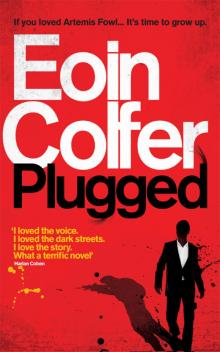 Plugged
Plugged The Opal Deception
The Opal Deception The Arctic Incident
The Arctic Incident The Wish List
The Wish List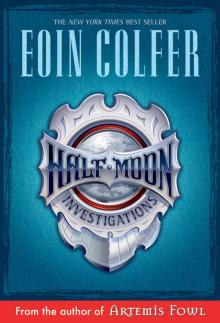 Novel - Half Moon Investigations
Novel - Half Moon Investigations The Supernaturalist
The Supernaturalist The Lost Colony
The Lost Colony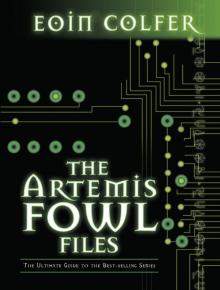 The Artemis Fowl Files
The Artemis Fowl Files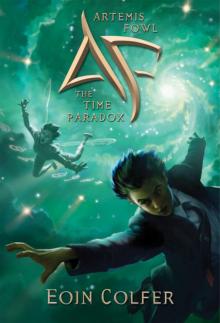 The Time Paradox
The Time Paradox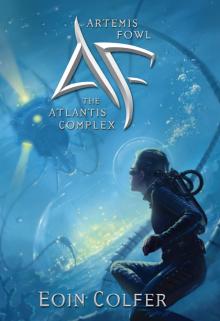 The Atlantis Complex
The Atlantis Complex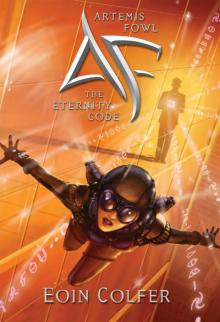 The Eternity Code
The Eternity Code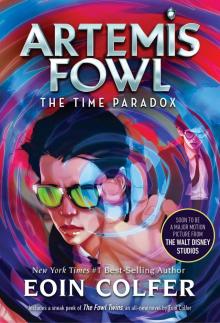 The Time Paradox (Disney)
The Time Paradox (Disney)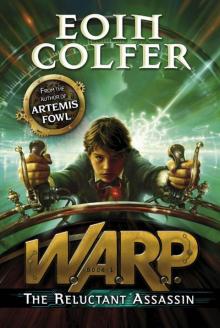 The Reluctant Assassin
The Reluctant Assassin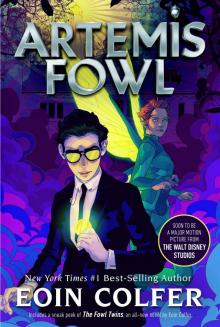 Artemis Fowl (Disney)
Artemis Fowl (Disney) Highfire
Highfire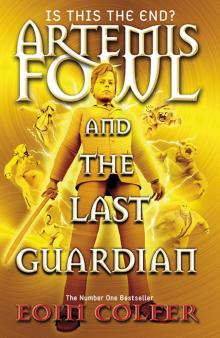 The Last Guardian
The Last Guardian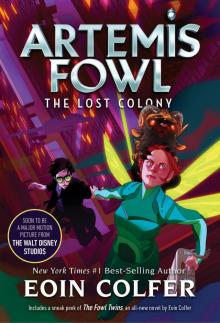 The Lost Colony (Disney)
The Lost Colony (Disney) Screwed: A Novel
Screwed: A Novel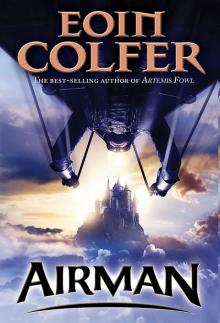 Novel - Airman
Novel - Airman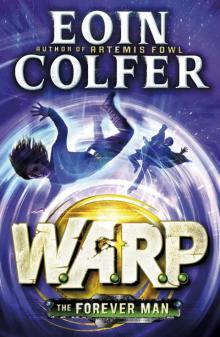 The Forever Man
The Forever Man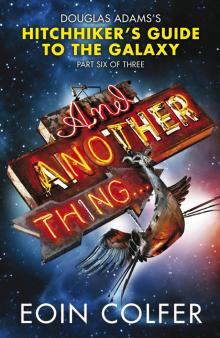 And Another Thing...
And Another Thing... The Seventh Dwarf
The Seventh Dwarf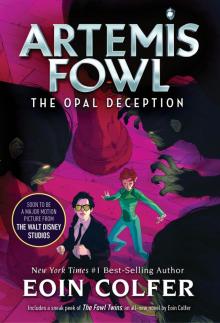 The Opal Deception (Disney)
The Opal Deception (Disney) The Fowl Twins Deny All Charges
The Fowl Twins Deny All Charges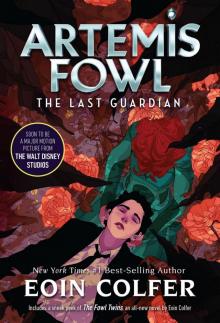 The Last Guardian (Disney)
The Last Guardian (Disney) The Hangman's Revolution
The Hangman's Revolution The Atlantis Complex (Disney)
The Atlantis Complex (Disney)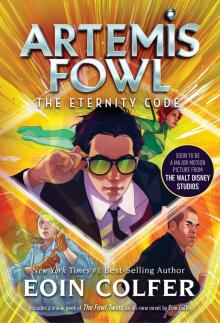 The Eternity Code (Disney)
The Eternity Code (Disney)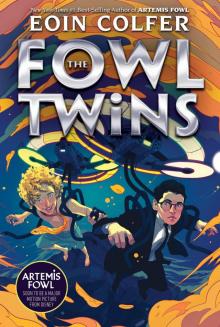 The Fowl Twins
The Fowl Twins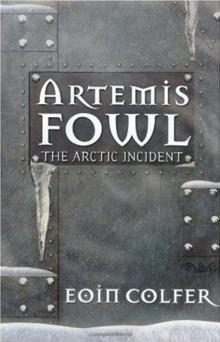 Artemis Fowl. The Arctic Incident af-2
Artemis Fowl. The Arctic Incident af-2 Artemis Fowl and the Atlantis Complex af-7
Artemis Fowl and the Atlantis Complex af-7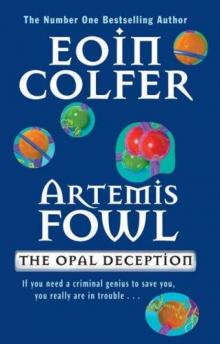 Artemis Fowl. The Opal Deception af-4
Artemis Fowl. The Opal Deception af-4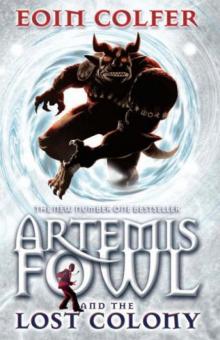 Artemis Fowl. The Lost Colony af-5
Artemis Fowl. The Lost Colony af-5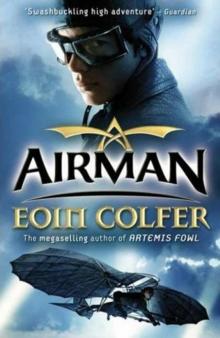 Airman
Airman Artemis Fowl af-1
Artemis Fowl af-1 Artemis Fowl: The Eternity Code af-3
Artemis Fowl: The Eternity Code af-3 Screwed dm-2
Screwed dm-2